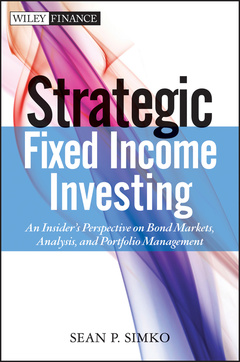Description
Strategic Fixed Income Investing
An Insider's Perspective on Bond Markets, Analysis, and Portfolio Management
Wiley Finance Series
Author: Simko Sean P.
Language: English
Subject for Strategic Fixed Income Investing:
Keywords
Fixed Income Portfolio Management, Strategic Fixed Income Investing, Bond Markets, Sean Simko, Ladder methodology, laddered bond strategy, evenly investing portfolio, portfolio of bonds, low risk portfolio investment, SEI portfolio management, fixed income, fixed income markets, portfolio management, SEI Investments, portfolio manager book, portfolio management book, fixed income investing
208 p. · 16x23.6 cm · Hardback
Description
/li>Contents
/li>Biography
/li>
Designing a fixed income portfolio is an essential skill of any investment manager or advisor. This book outlines the critical components to successfully navigate through stable and turbulent markets, using real-life lessons from a seasoned institutional asset manager. The first section includes commentary on the changing fixed income market and overall economy, while the second section outlines the processes to navigate these ever-evolving markets including portfolio construction, the Federal Reserve, credit analysis and trade execution. Ladder Methodology is highlighted and the book discusses its pros and cons, gives examples of both well-constructed and poorly executed laddered bond portfolios and offers alternatives to traditional asset classes.
- Benefit from lessons learned, providing real life examples of market scenarios and trades
- Prepare fixed income portfolios that can weather any storm
- Written by Sean P. Simko, an expert on fixed income investing, who shares his investing experiences from the past 16 years
- Outlines the key principles of the Ladder strategy
From strategy to execution, Strategic Fixed Income Investing offers the road map to help investment managers prepare portfolios that will insulate investments against adverse market conditions.
Preface xi
Acknowledgments xiii
Part One The Investing Environment 1
Chapter 1 Expect the Unexpected 3
The Model Has Changed 4
Lessons Learned 4
From Bad to Worse 5
Chapter 2 Navigating through Troubled Water 7
Debt Ceiling 8
Triple A: Lost, but Not Forgotten 8
Possible, but Not Probable, Consequences 9
Warning Signs 12
Chapter 3 Lessons Learned 15
Patterns Emerge 16
Money Markets 18
Treasury Bills, the Favored Asset Class 20
Municipals Felt the Pain as Well 25
Auction-Rate Markets Were Hit Hard 27
Chapter 4 Direction in a Sometimes Directionless Market 29
Finding Direction 30
Part Two The Fixed Income Investor 35
Chapter 5 Define the End Investor 37
Risk 40
Risk-Averse Investor 42
A Problematic Trade? 43
Risk-Taking Investor 44
Define Your Strategy 45
Active Strategy 47
Chapter 6 Portfolio Construction 49
Factor 1: Defining Your Risk 50
Factor 2: Aligning Goals 51
Conservative Strategy 54
Moderate Strategy 56
More Aggressive Strategy 56
Factor 3: Portfolio Analysis 59
Reduction of Credit Risk 62
Government Securities 64
Risks to Consider 65
Bottom Line 69
Chapter 7 Asset Allocation 71
The Road Map 72
Going Global 76
Chapter 8 The Federal Reserve and Central Banks 81
Hawks and Doves 82
The Fed Funds Rate 82
A Short-Term Fixed Income Investor 83
Hooked on Accommodation 83
Deposits with Central Banks 84
What about the United States? 86
FOMC: Look for Clues from the Fed Statement 88
What to Look For from the Fed Clues? 88
FOMC Statement: August 2011 89
QE or Not QE 92
Calming Statements for Investors 93
Chapter 9 The Economy and the Markets 95
The Payroll Picture: The Backbone to the Economy 97
Bureau of Labor Statistics Website 97
Inflation: A Fixed Income Investor’s Enemy 103
Consumption: America’s Fuel 109
The Federal Chairman: The Wizard Himself 110
Chapter 10 The Yield Curve 111
The Spread 115
The Money Market Arena 116
The Direction of Rates 118
A Steep Yield Curve 119
A Flat Yield Curve 120
An Inverted Yield Curve 121
Listen to the Curve 123
Chapter 11 The Ladder and Why You Need One 125
How It Works 126
The Concept 126
The Goal 129
The Long End Poses Challenges 131
The Front End Is Technical 133
Varieties of Short-Term Strategies 133
The Sweet Spot 134
Liquidity 134
Consistent Coupons 137
Why Is Supply Important? 138
Performance and How to Measure It 140
Low-Turnover Dilemma 141
Success of a Strategy 142
Chapter 12 Alternatives to a Traditional Ladder Strategy 145
TIPS: The Other Treasury 147
Break-Even Opportunity 148
Consider MBS Pools of Mortgages 150
Consider Corporate Bonds 151
Floating-Rate Notes 153
What Is LIBOR? 154
A Deeper Look at LIBOR 154
The Bottoming Process 156
Chapter 13 Credit Analysis 159
The Agency 159
Credit Analysis: Necessary, Not Optional 160
Credit for a Passive Strategy 161
After the Initial Approval 163
Not All Bonds Are Equal 164
Stay Ahead of the Herd 166
Chapter 14 The Four Pillars of Trade Execution 169
The First Pillar: Executed Price 171
The Second Pillar: Dealer Inquiries 173
The Third Pillar: Liquidity 174
The Fourth Pillar: Ease of Transaction 174
Chapter 15 There Are No Roadblocks, Just Detours 177
Know What You Own 177
Banking Sector 178
Go with Your Gut! 179
Don’t Take It Personally 181
Trapped in Purgatory 182
Index 185
SEAN P. SIMKO is the Head of Fixed Income Portfolio Management at SEI, and a sought-after expert on fixed income investing and the financial markets. He leads a team of investment professionals responsible for research, analysis, implementation, and ongoing portfolio management of over $7 billion of fixed income strategies. Prior to joining SEI, Mr. Simko was vice president and portfolio manager for Weiss Peck & Greer Investments and was responsible for managing approximately $6 billion in assets through various strategies including short duration, tips, structured products, futures, and currencies. Mr. Simko has appeared on Bloomberg TV and radio and frequently on Money Matters, and he is regularly quoted in the Wall Street Journal and other mainstream publications. He has written numerous articles for financial magazines, including most recently, December's issue of Investment Advisor.

